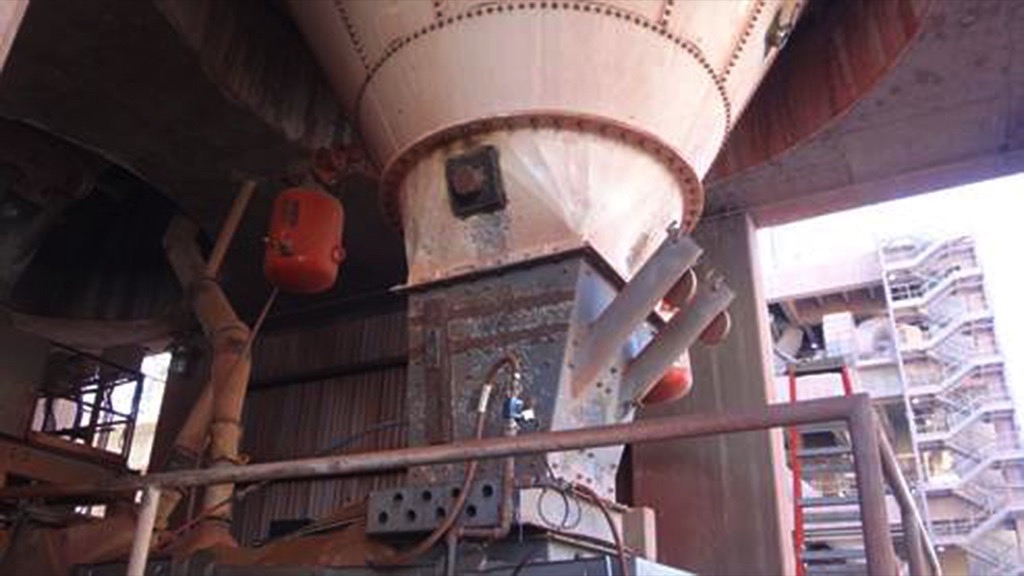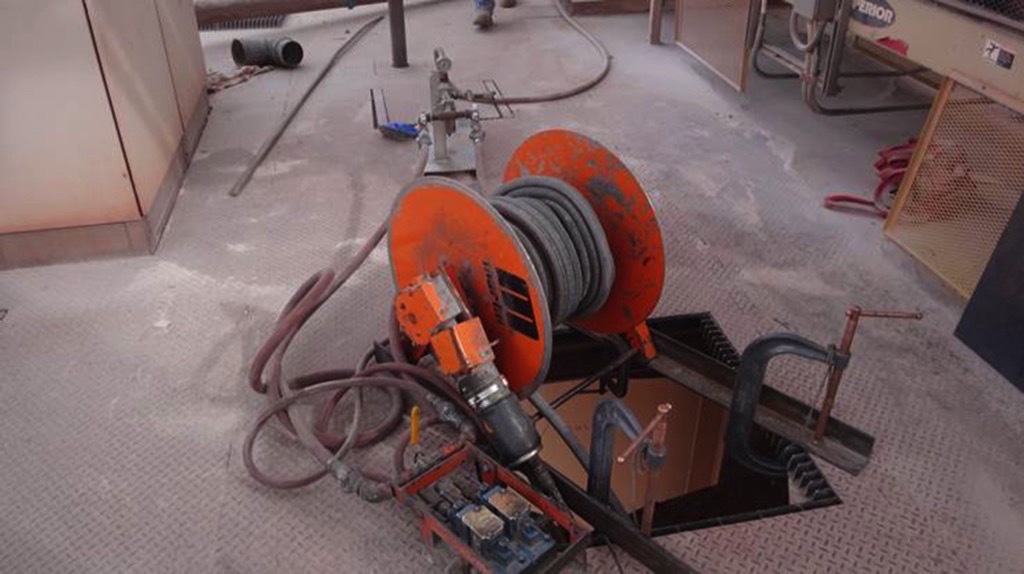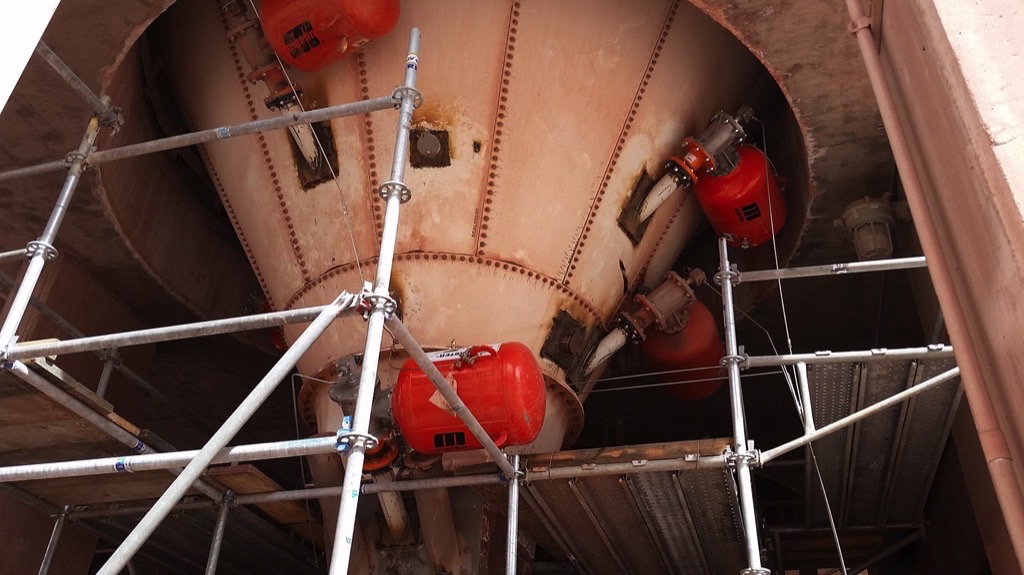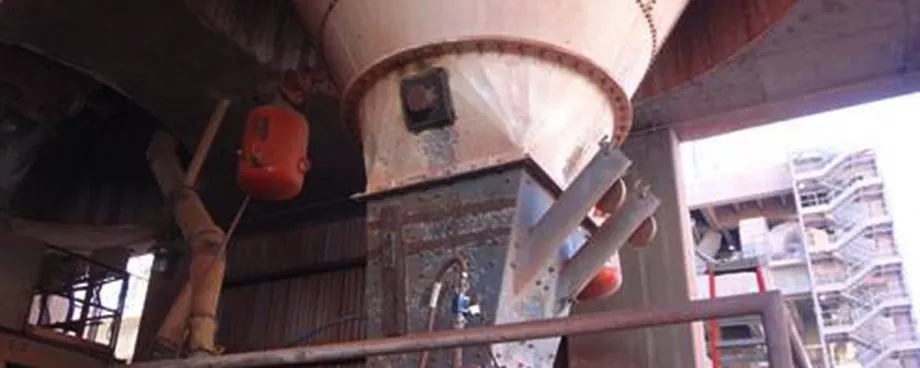(From the archive of "bulk solids handling", article published in Vol. 37 (2017) No. 1, © 2017 bulk-online.com)Limestone can be a particularly tricky material. When crushed to the size needed for cement meal, damp limestone can adhere to belts, chute surfaces and silo walls, accumulating until it eventually creates clogs and forces unscheduled downtime.

The Drake Cement facility ten miles north of Paulden, AZ, experienced the issue firsthand during the winter of 2015 and 2016. In this historically dry state, moisture had only been an issue during snowy winters and monsoon weather in July and August, which sometimes delivered sudden torrential rains. But the long drought in the region gave way to drastically wetter El Niño conditions, affecting how raw cargo normally flowed through Drake’s material handling system. Operators found that the problem was acute in the silo storing limestone for the raw mill.“This plant is one of the most state-of-the-art operations of its kind, with advanced operating and pollution controls found in only a few other facilities in the world,” explained Jose Venegas, Maintenance Manager at Drake Cement. “Our cement plant has a rated capacity of 660,000 tons (598,741 metric tons) of high-quality Portland cement per year.”
Dry Process
The limestone is crushed to 2 in (50 mm) minus, with the smallest particles about 1/16th in (1.5 mm) in diameter, and run through a conveying process to the limestone stockpile. During normal production, 60 tph (54.4 metric t/h) of low limestone is added to the raw grinding mill.Along with the calcined limestone mixture, uncalcined gypsum is added at the end of the process to create Drake’s Type II/V (LA) Portland cement. The plant makes products that conform to the requirements of ASTM C-150 for Types II/V, low alkali cement.
Drastic Measures
A key component of Drake’s dry-process manufacturing is efficient material flow. Excessive rain in the months of January through March caused the limestone being extracted from the nearby quarry to have elevated moisture levels. Little of that water is lost in the crushing process, and dry material can absorb moisture as it is reduced in size. So in the winter months, by the time the material lands in the 536-ton (486 metric ton) low limestone silo, it is nearly saturated. Prior to the winter of 2015, the silo had not experienced a single flow disruption, nor had it required cleaning due to the aid of two Martin XHV air cannons. Positioned perpendicular to the material flow, the units delivered a strong shot of compressed air across the vessel to dislodge stuck material. Adequate in previous years to keep material flowing at required volumes through all seasons, the air cannons were unable to prevent clogging at such high moisture levels.The new weather situation caused the silo to clog every week. Starting at the lower slope of the hopper, highly compacted material quickly moved up the inner shell of the circular 50.7-ft (15.4 m) tall, 18-ft (5.4 m) wide silo, forming 8-ft (2.4 m) thick walls around the mouth and allowing only a narrow rathole that eventually clogged at the silo’s 2-ft (0.6 m) wide shaft leading to the weigh feeder. This required workers to spend up to 12 hours to clean it out using compressed air and other tools. As the winter got worse, so did the clogging problem, and soon the large structure would only take two hours to fill. To remedy this, operators used CO2 blasting tubes every 15 to 30 minutes.
Limestone Snowballs
When Martin Engineering National Business Development Manager Doug Brown arrived at the plant, he found a silo so compactly clogged that it had halted the entire production process. “Inspecting the silo for a solution, we realized that the limestone could be packed like snowballs, dense enough to stick to the wall when thrown,” said Brown. “This demonstrated just how serious the problem was. We luckily had a silo cleaning crew that had just finished a job in Tucson, AZ, so they were quickly dispatched north to the plant.”

The experienced two-man crew immediately set up a Martin heavy duty whip. Powered by compressed air, the device can be equipped with a variety of flails and cutting edges to knock down accumulated material without damaging the silo’s walls or support structure. The coiled modular boom extends up to 28 ft (8.5 m) and can clean vessels as wide as 60 ft (18 m) in diameter and 225 ft (68.5 m) tall.Operating from the bottom of the silo up, the team completely cleaned out the densely clogged silo in only 11 hours while the plant resumed production.
Long Term Prevention
Once the silo had been completely evacuated, Brown – a flow aid specialist – realized that the ongoing problem could be remedied by utilizing Drake’s current stockpile of air cannons. Using an innovative placement strategy, Brown was certain that the cannons could safely prevent buildup and promote efficient high-volume material flow, no matter how moist or dense the limestone.

Rather than the two cannons at the bottom of the limestone silo firing across the cargo flow, five cannons were strategically placed around the vessel. Installed with a wide 4-in (101 mm) valve, three 70-liter (88 lb/40kg) Tornado air cannons were placed on the lower incline of the cone at a 30º downward angle against the 60º slope in the 6 and 12 o’clock positions (one side of the silo was inaccessible). In the 3 o’clock position, one air cannon was situated at the 2-ft-wide shaft, and another was added to the upper silo to aid in loosening material. The cannons deliver a strong pressurized blast of air down the wall of the silo, dislodging adhered material and introduces it back into the process flow.“This type of air cannon configuration has shown to be highly effective in promoting flow and preventing clogging,” Brown pointed out. “It has the benefit of directing the air cannon’s blast to dislodge the material, delivering a more powerful shot on accumulation that’s stuck to the vessel wall.”A programmable logic control (PLC) system centrally placed in the facility coordinates and monitors the timing and firing sequence of each unit at all locations, including the limestone silo. This made expanding the system easier, since the cannons use a positive-acting valve that is triggered by a solenoid panel set a safe and convenient distance – up to 200 ft (61 m) – from the cannons. Connected to the plant’s compressed air system, the improved air path of the Tornado fills the reservoir 3-4 times faster than typical designs. The positive-acting valve opens in response to a surge of air sent by the solenoid, amplifying the discharge force by 20% and reducing the chance of misfires.During the wet winter and monsoon months, the cannons were activated approximately every hour, but throughout the rest of the year the system has a firing sequence of only 4-5 times per day. “We also added a layer of protection that the silo didn’t have before by installing an automated weight sensor,” Venegas explained. “If the silo exceeds 40 t of downward pressure, logistical software detects the buildup and fires the cannons. This sequence can also be manually activated at the weigh feeder, the solenoid panel or in the control room.”
Results Demonstrated by Production Gains
A two-man team did the air cannon installation over a two-day period, coinciding with other maintenance. Since installation, plant production has returned to normal levels, and the silo has not been shut down for cleaning.There has been no unscheduled downtime due to clogging, which has greatly increased production, especially through heavy weather periods. The use of CO2 tubes has been ceased altogether. When a buildup is detected, workers no longer are required to get close to the area to resolve it, increasing plant safety and reducing the number of man hours required to maintain the silo.“This equipment upgrade has paid for itself many times over,” Venegas said. “We are extremely happy with the results. The service was fast, responsive and well coordinated. During our next scheduled outage, we’re going to have a Martin Engineering team out here to consult on other areas where we might need air cannons, so that we can maximize production. We look forward to an ongoing and productive relationship.
■







